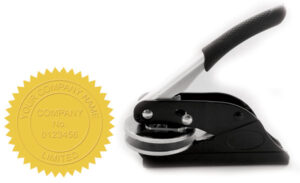Let’s get one thing straight: not that all logos will translate well to a custom embosser. Because embossing logos are black and white artwork, this is the explanation. Colour and half-tone photos of the custom embosser are now available for logos. The good news is that you can convert many of these logos to black and white graphics.

Most large firms have already created black and white versions; all you have to do is ask. But you’ll have to do it yourself for the rest of the people who run small enterprises or associations. You may quickly transform your logo to black and white if created as a vector file. Grayscale photos are equally simple to convert. Bitmap images are the source of the issue. You’ll almost certainly need to engage a graphic artist to make the adjustments.
Your Logo’s Resolution
Another significant issue is the artwork’s resolution. You’ll need a resolution of at least 300 dpi to the embosser. Printing your symbol on your specific computer, approximately the size of a custom embosser is an easy way to tell. Your logo will create an embosser if the edges of the picture are clean or almost smooth. Your logo will not operate as an embosser if the edges are ragged.
Logo Line Thickness for Embossing
Logos with very tiny lines are difficult to the embossing. To make an embossed image, an embosser pushes the paper up. The narrower the line, the less likely it is to be visible on the paper. A reasonable rule of thumb is that no line should be less than 1 point thick. The guideline changes to 2-point width if you’re embossing thicker paper.
What kind of papers are embossed?
Most of the custom embosser stamp with logos work well on papers up to 25 lb. When you go thicker, you lose image crispness, which causes issues. As a general ethic, the thicker the paper, the bolder the logo to emboss. There are a few techniques for embossing thicker paper with an embosser.

The embosser can be double-pumped. Another technique is to fill a perfume bottle with water. Ten minutes before embossing, lightly spray both sides of the paper. This softens the paper, which allows you to improve the embossing picture. You can emboss various thin card stocks with this method.
What pointers to keep in mind when looking for a custom embosser that suits your requirements?
Understanding those possibilities and determining your requirements will make choosing the best embossing simple. Here are five suggestions to help you select the best-personalized embosser.
Recognize the Look You Wish to Achieve
Many clients believe that embossing using a custom embosser will produce the same result as having something professionally printed or embossed; however, this is not the case. The result will have a distinctive appearance, so understanding how you want it to look will help you decide which process to use. The biggest advantage of buying an embosser is that you will save money.
Inform the company you’re buying from about your embosser requirements
There are various varieties of embossers, each with its own set of advantages and disadvantages. When placing an order, be sure to provide information about your intended purpose and ask the company you’re working with what their embossers will and won’t perform. A handheld embosser, for example, is an excellent alternative if you want something tiny and lightweight for easy storage and portability.

Embossing authenticates and distinguishes business cards, company reports, and formal papers. It adds your company’s name to key documents and identifies you as the owner. At the same time, the stationery is what permits the embossing to be as effective as it can be.
Stamp Store provides a large selection of custom embossers by making it simple and economical to design and acquire the goods you require. Contact us now!!
